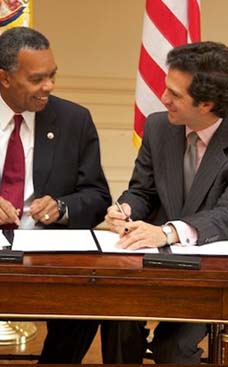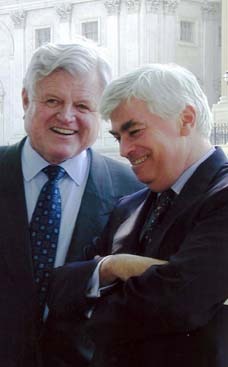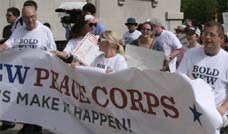2010.06.22: Peace Corps Releases Comprehensive Agency Assessment Report
Peace Corps Online:
Peace Corps News:
Library:
Peace Corps: Safety and Security of Volunteers:
Peace Corps Safety and Security: Newest Stories:
2010.06.17: Washington Times says Safety at risk for Peace Corps volunteers :
2010.06.22: Peace Corps Releases Comprehensive Agency Assessment Report
Peace Corps Releases Comprehensive Agency Assessment Report
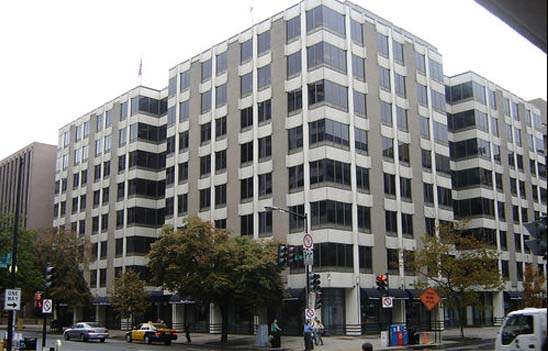
Peace Corps Director Aaron S. Williams made a commitment during his July 2009 confirmation hearing to undertake a comprehensive assessment of Peace Corps' operations. In December 2009, Congress included a provision in the Consolidated Appropriations Act of 2010, requiring the Director of the Peace Corps to submit a comprehensive assessment report. Subsequently, Williams assembled a team that worked independently over the past six months to evaluate and make recommendations to strengthen and reform Peace Corps' operations. The final report was submitted to Congress on June 14, 2010. The assessment team asked the question, "If the Peace Corps were created today, what should it look like?" The answer: "The Peace Corps will be a leader, in partnership with others, in the global effort to further human progress and foster understanding and respect among people."
PCOL Comment: The Peace Corps has always neglected the third goal, allocating less than 1% of their resources to it, so when Aaron Williams promised Senator Dodd to provide a "Comprehensive Assessment Report" with ideas to strengthen and reform the agency's operations we expected to see some forceful recommendations to address this weakness. In 2008, Peace Corps Director Ron Tschetter, the only RPCV who has served as both the agency's Director and Chairman of the Board of the NPCA, proposed a Peace Corps Foundation that would be a private charitable non-profit corporation dedicated to the third goal whose purpose would be to increase public awareness within the United States of Peace Corps Volunteer experiences, and the diversity of the countries in which they serve. The foundation would be totally financed with private funds from corporations, foundations, and private individuals and would not be a federal agency or receive funding from the US government. Unfortunately, the "Comprehensive Assessment Team" continued the Peace Corps' traditional disregard for the third goal by neglecting to consider the establishment of the "Peace Corps Foundation" even though the legislation to establish a Peace Corps Foundation was already drafted in bill form two years ago ready to be introduced to Congress and the Peace Corps has already received approval from the OMB, Treasury, IRS, the State Department to go ahead with the foundation. This critical omission by members of the "Comprehensive Assessment Team" to not even mention the Peace Corps Foundation, may leave some with the overall impression that their report is perfunctory in nature, written only to satisfy Senator Dodd's request and not to seriously address the issues at hand. Although the comprehensive report does recommend that the agency establish a third goal strategy, we believe that another team needs to be appointed to do a comprehensive study on the third goal and methods to achieve it - and that the team needs to seriously address the establishment of a Peace Corps Foundation. If members of the Obama administration have good reasons why they do not support the establishment of a Peace Corps Foundation whose charter would be to support third goal activities, then the Peace Corps should explain these reasons to the RPCV community and Friends of the Peace Corps. This issue is too important to be swept under the table.
Peace Corps Releases Comprehensive Agency Assessment Report
Peace Corps Releases Comprehensive Agency Assessment Report
WASHINGTON, D.C. Director Aaron S. Williams is pleased to announce the completion of the Peace Corps Comprehensive Agency Assessment Report. Director Williams stands firmly behind the assessment and will brief agency staff, U.S. Congress, and returned Peace Corps volunteer groups on how the agency will implement the report's strategic vision and recommendations.
"This is an exciting time to be a part of the Peace Corps as we strengthen and reform agency operations and invest in quality improvements," said Director Williams. "This report will serve as a plan for excellence and represents the Obama Administration's commitment to efficient and effective government while expanding public service opportunities for all Americans."
Williams made a commitment during his July 2009 confirmation hearing to undertake a comprehensive assessment of Peace Corps' operations. In December 2009, Congress included a provision in the Consolidated Appropriations Act of 2010, requiring the Director of the Peace Corps to submit a comprehensive assessment report. Subsequently, Williams assembled a team that worked independently over the past six months to evaluate and make recommendations to strengthen and reform Peace Corps' operations. The final report was submitted to Congress on June 14, 2010.
The team led an extensive outreach effort to develop the assessment, conducting research and gathering suggestions from Volunteers, returned Volunteers, agency staff, federal agencies, Peace Corps partners, the National Peace Corps Association, and many others. Additionally, a literature review of articles from Peace Corps supporters and critics informed the report.
The final assessment report is available at the following links:
http://peacecorpsonline.org/messages/documents/PC_Comprehensive_Agency_Assessment.pdf
http://peacecorpsonline.org/messages/documents/PC_Comprehensive_Agency_Assessment_Appendices.pdf
Following is the executive summary, vision, and summary of findings, recommendations, and strategy for implementation:
A Comprehensive Agency Assessment The Peace Corps June 2010
The Peace Corps A Comprehensive Agency Assessment
Final Report
June 2010
I. EXECUTIVE SUMMARY
A. A VISION FOR THE PEACE CORPS AT FIFTY
Fifty years ago, President Kennedy launched an innovative new program to spearhead progress in developing countries and promote friendship between the United States and the people of the world. Fifty years later, the mission and the three goals that inspired the birth of the Peace Corps are still relevant. The passion that drove the creation of the Peace Corps is still very evident in the lives of the Volunteers who serve around the world today. The Peace Corps at fifty is ready for a strong new beginning-rooted in the vibrant past of those early years, yet ready to harness twenty-first century American intellectual power, innovation and commitment to results.
The Peace Corps is still very much in demand from both its host countries and the American public. Presidents and cabinet ministers in dozens of countries credit their start to Peace Corps Volunteers who touched their lives at an early age. Peace Corps Volunteers in 77 host nations are kindling a fire in the leaders of tomorrow. The fact that requests for Volunteers still far exceed the Peace Corps' capacity to place them within its budget is a clear and convincing measure of the Peace Corps' importance to many nations and its impact around the world. Peace Corps Volunteers are America's best and most cost effective grassroots development workers, magnifying the impact of government and donor investments at the community level and ensuring that efforts funded by others are community-owned and sustained. Peace Corps Volunteers are America's best ambassadors, building relationships with strategic partner countries from the ground up in communities across the globe.
The assessment team asked the question, "If the Peace Corps were created today, what should it look like?" The answer: "The Peace Corps will be a leader, in partnership with others, in the global effort to further human progress and foster understanding and respect among people."
Excitement, engagement, and effectiveness are the terms that should characterize the Peace Corps as it moves toward the future. As the agency prepares to turn fifty, the agency needs to be in a position to look less in the rear-view mirror at its rich history, but rather, look forward firmly believing its best days are yet to come.
The Peace Corps is not only still relevant-it is more important than ever in this increasingly complex twenty-first century world. The Peace Corps' leadership is ready to take the agency to a new level of engagement, with an inspiring new strategy to both revitalize the Peace Corps and achieve even greater impact in the nations it serves.
B. THE PEACE CORPS' MISSION AND THREE GOALS
The agency's mission and three goals have historically provided the framework for defining its vision-and should continue to do so in the future. However, the three goals are not sufficient for setting the agency's future direction, articulating its role in the world, and establishing the baseline and reference points for strategic decision-making in the future. While the three goals still remain paramount, the Peace Corps needs to clearly articulate its strategies for how it will meet its three goals in a world very different from the one in 1961 when it was founded. The Peace Corps' new strategy must take into account the changing face of both the United States and the countries it serves. The twenty-first century Peace Corps is fully capable of achieving more than ever before, but needs a better roadmap to strategically guide its future.
As the world has advanced and become more sophisticated through new technologies, as new problems have arisen and old problems have revealed their complexity and intractability, the Peace Corps needs to evolve in order to better prepare and support Volunteers and their partners in addressing community needs.
Countries worldwide now have university trained leaders and national development strategies. They also have high expectations of the Americans who come to live and work in their communities. No longer can the agency send Volunteers to serve without ensuring that there is important work awaiting them and that they have received the very best training and preparation for completing their assignments.
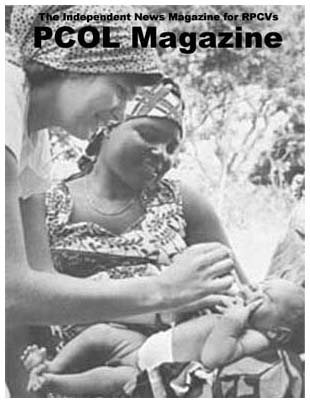
No longer is the Peace Corps the only American volunteer organization operating internationally. Today's Volunteers have many other options for service and are aware of those options. The agency needs to recognize that it operates in a far more competitive environment and adopt a new recruiting model so that it can continue to attract the very best Volunteers.
Finally, Americans hold the Peace Corps accountable for using scarce resources in the most effective ways possible. The agency needs to maximize its impact, and doing so requires a rigorous decision-making process to optimize resource allocation, and an active monitoring and evaluation function that measures progress and strengthens management decisions.
These messages came through loud and clear in the interviews the assessment team conducted, the reports the team reviewed, and the hundreds of responses the team received from Volunteers, returned Volunteers, agency staff, host country partners, Members of Congress and their staff, and others. If the Peace Corps is to meet the demands of the 21st century, it must develop a dynamic plan of action with clearly articulated strategies to take it into the next 50 years.
As stated at the outset, the assessment team believes this is a key moment to renew excitement for the unique experience that Peace Corps service provides, to increase engagement with the international community through creative and innovative partnerships, and to enhance the effectiveness of the Peace Corps worldwide.
C. THE AGENCY ASSESSMENT
C.1. Background
The Consolidated Appropriations Act, 2010 (Public Law 111-117) enacted on December 16, 2009 provided the Peace Corps with the largest year-to-year funding increase in more than a decade. It also included a 3 provision requiring the Director of the Peace Corps to submit a report to the Committees on Appropriations on the findings of a comprehensive assessment in the areas listed below:
1. Improving the recruitment and selection process to attract a wide diversity of highly and appropriately skilled volunteers;
2. Training and medical care for volunteers and staff;
3. Adjusting volunteer placement to reflect priority United States interests, country needs and commitment to shared goals, and volunteer skills;
4. Coordinating with international and host country development assistance organizations;
5. Lowering early termination rates;
6. Strengthening management and independent evaluation and oversight; and,
7. Any other steps needed to ensure the effective use of resources and volunteers, and to prepare for and implement an appropriate expansion of the Peace Corps.
The Director of the agency also asked the assessment team to address how the agency can best strengthen third goal activities and agency reporting mechanisms.
C.2. Assessment methodology
The assessment methodology is described in greater detail in chapter III of this report. A major hallmark of the agency assessment was the outreach effort utilized by the team to gather a large number of diverse opinions from all stakeholders. The observations, conclusions, and recommendations presented in this report are based on this major outreach initiative that generated strong input from multiple sources, including:
An extensive literature review included internal documents and external documents from both supporters and critics of the agency;
Meetings and interviews with stakeholders, including current and former Peace Corps staff, returned Peace Corps Volunteers, currently serving Volunteers, and members of Congress and congressional staff;
Surveys on currently serving Volunteers, returned Volunteers, and newly recruited Volunteers as they prepared to travel to their posts;
A strong outreach effort soliciting input from currently serving Volunteers and Peace Corps staff through an e-mail address created by the assessment team for this purpose;
Strategic planning sessions with the agency's management team; and,
Participation in agency conferences with country directors, program and training officers, and internal working groups.
The outreach effort yielded some important cross-cutting themes that in turn led to the development of the vision, the six supporting strategies, and the implementation plan presented in this report.
C.3. Organization of the report
The report is divided into eleven chapters that respond to the seven areas listed in the Consolidated Appropriations Act, 2010 enacted on December 16, 2009.
Each chapter of the main body of the report consists of three sections:
Observations on the current system;
Recent changes in the organization; and,
A summary of findings, recommendations, and a strategy for implementation.
At the end of each chapter, the recommendations are listed and an implementation matrix is also provided which details the lead and supporting offices responsible for implementation of each recommendation, including a time line for completion.
The Peace Corps' mission-to promote world peace and friendship-has three goals:
1. Helping the people of interested countries in meeting their need for trained men and women.
2. Helping promote a better understanding of Americans on the part of the peoples served.
3. Helping promote a better understanding of other peoples on the part of Americans.
II. VISION
A. VISION FOR THE PEACE CORPS AT FIFTY
Fifty years ago, President Kennedy launched an innovative new program to spearhead progress in developing countries and promote mutual understanding between the United States and the people of the world. Fifty years later, the mission and the three goals that inspired the birth of the Peace Corps are still relevant. The passion that drove the creation of the Peace Corps is still very evident in the lives of the Volunteers who serve around the world today. The Peace Corps at fifty is ready for a strong new beginning-rooted in the vibrant past of those early days, yet ready to harness twenty-first century American intellectual power, innovation and commitment to results.
The Peace Corps is still very much in demand from both its host countries and the American public. Presidents and cabinet ministers in dozens of countries credit their start to Peace Corps Volunteers who touched their lives at an early age. Peace Corps Volunteers in 77 host nations are kindling a fire in the leaders of tomorrow. The fact that requests for Volunteers still far exceed the Peace Corps' capacity to place them within its budget is a clear and convincing measure of the Peace Corps' importance to many nations and its impact around the world. Peace Corps Volunteers are America's best and most cost effective grassroots development workers, magnifying the impact of government and donor investments at the community level and ensuring that efforts funded by others are community-owned and sustained. Peace Corps Volunteers are America's best ambassadors, building relationships with strategic partner countries from the ground up in communities across the globe.
The assessment team asked the question, "If the Peace Corps were created today, what should it look like?" The answer:
"The Peace Corps will be a leader, in partnership with others, in the global effort to further human progress and foster understanding and respect among people."
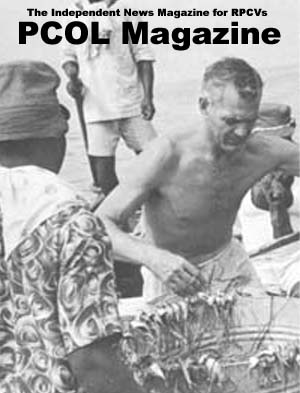
Excitement, engagement, and effectiveness are the terms that should characterize the Peace Corps as it moves into the future. As the agency prepares to turn fifty, the agency needs to position itself to be one that looks less in the rear-view mirror at its rich history, but rather, looks forward firmly believing its best days are yet to come.
The Peace Corps is not only still relevant-it is more important than ever in this increasingly complex twenty-first century world. The Peace Corps' leadership is ready to take the agency to a new level of engagement, with an inspiring new strategy to both revitalize the Peace Corps and achieve even greater impact in the nations it serves.
B. THE PEACE CORPS' MISSION AND THREE GOALS
The agency's mission and three goals have historically provided the framework for defining its vision-and should continue to do so in the future. However, the three goals are not sufficient for setting the agency's future direction, articulating its role in the world, and establishing the baseline and reference points for strategic decision-making in the future. While the three goals still remain paramount, the Peace Corps needs to clearly articulate its strategies for how it will meet its three goals in a world very different from the one in 1961 when it was founded. The Peace Corps' new strategy must take into account the changing face of both the United States and the countries in which it serves. The twenty-first century Peace Corps is fully capable of achieving more than ever before, but needs a better roadmap to strategically guide its future.
As the world has advanced and become more sophisticated through new technologies, as new problems have arisen and old problems have revealed their complexity and intractability, the Peace Corps needs to evolve as well in order to better prepare and support Volunteers and their partners to address community needs.
Countries worldwide now have university trained leaders and national development strategies. They also have high expectations of the Americans who come to live and work in their communities. No longer can the agency send Volunteers to serve without ensuring that there is important work awaiting them and that they have received the very best training and preparation for completing their assignments.
No longer is the Peace Corps the only American volunteer organization operating internationally. Today's Volunteers have many other options for service and are aware of those options. The agency needs to recognize that it operates in a far more competitive environment and adopt a new recruiting model so that it can continue to attract the very best Volunteers.
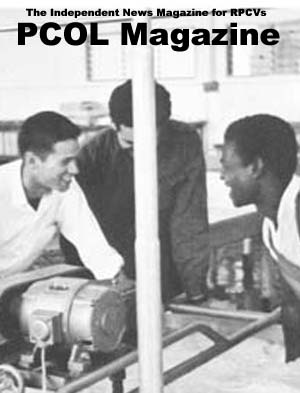
Finally, Americans hold the Peace Corps accountable for using scarce resources in the most effective ways possible. The agency needs to maximize its impact, and doing so requires a rigorous decision-making process to optimize resource allocation, and an active monitoring and evaluation function that measures progress and strengthens management decisions.
These messages came through loud and clear in the interviews the assessment team conducted, the reports the team reviewed, and the hundreds of responses the team received from Volunteers, returned Volunteers, agency staff, host country partners, Members of Congress and their staff, and others. If the Peace Corps is to meet the demands of the 21st century, it must develop a dynamic plan of action with clearly articulated strategies to take it into its next 50 years.
As stated at the outset, the assessment team believes this is a key moment to renew excitement for the unique experience that Peace Corps service provides, to increase engagement with the international community through creative and innovative partnerships, and to enhance the effectiveness of the Peace Corps worldwide.
C. LESSONS LEARNED: CRITICAL ELEMENTS OF A STRATEGY FOR THE PEACE CORPS
When the assessment team asked the broader Peace Corps community for opinions on strengthening the agency, there was no shortage of passionate responses. The assessment team analyzed this rich-and abundant-feedback to determine common elements mentioned from varying perspectives and looked to build on these elements to develop a strategy for reforming operations. The assessment report is grounded in these four critical elements, which are the key strengths and understandings learned from 49 years of the Peace Corps' operations.
C.1. Meaningful work
The Peace Corps' success and impact is dependent upon the agency's ability to provide capable, prepared Volunteers to meet defined host country needs (Goal 1). Goal 1 is the engine that pulls the Peace Corps train, and facilitates the achievement of Goals 2 and 3 aimed at building greater understanding between Americans and the world. Therefore, the Peace Corps' effort and resources should be targeted to improve the quality and professionalism of Volunteer work, ensuring every Volunteer has a meaningful job and is properly trained to effectively carry it out.
C.2. Partner
The Peace Corps is at its best when it works with and complements the efforts of others, including U.S. government partners. Foreign governments, organizations, and communities around the world place confidence in the Peace Corps when requesting a Volunteer. Volunteers are requested by host country partners and marketed by the Peace Corps' staff as individuals who come to assist their communities and promote mutual understanding. The Peace Corps' vision should reflect the importance of its role as a partner in supporting locally identified development priorities. The Peace Corps' impact is minimized and sustainability is limited, when it acts as an independent agent without strong partners.
C.3. Niche
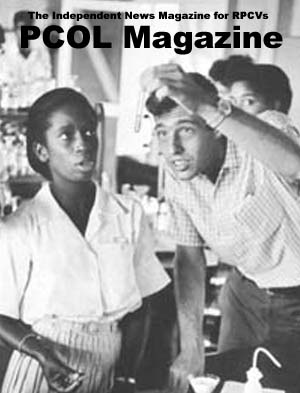
The Peace Corps' operational model is unique, and it is also its major strength. Volunteers live and work in communities where other service organizations tend not to go, and they do so for extended periods of time. Volunteers learn the local language and culture and their work is driven by respect for their hosts. The relationships that Volunteers build with their partners at the national and community level are based on this unique approach. It also forms the core of the agency's effectiveness. Very few other organizations make and achieve such commitments-no other U.S. government agency comes close.
C.4. Volunteers
Approximately 85 percent of the agency's Volunteers are recent college graduates with little or no professional experience. While the recruitment of individuals with greater professional skills and relevant skill sets has increased in recent years, younger, less experienced Volunteers will continue to form the foundation for the Peace Corps' operations. The Peace Corps must be committed to providing these less experienced Volunteers with the skills they need to be effective, and to assigning them to communities where their skills and expertise allow them to have meaningful work and a quality volunteer experience. The Peace Corps should continue to recruit higher skilled applicants, but it should resist planning as if the majority of its applicants come already trained.
D. THE PEACE CORPS' SIX POINT STRATEGY
Based on input to the assessment from individuals and groups in the United States and overseas, the assessment team worked with the Peace Corps' senior leadership to define a set of six key strategies to 8
guide the agency in the coming decade. These strategies are listed below and then described in more detail in the following section.
The following six strategies are the centerpiece of that effort:
1. Target the Peace Corps' resources and country presence across countries according to specific country selection criteria to maximize grassroots development impact and strengthen relationships with the developing world.
2. Focus on a more limited number of highly effective technical interventions that will enable the Peace Corps to demonstrate impact and achieve global excellence.
3. Embrace generalist Volunteers, recruit them recognizing the competition for their services, and provide them with training and comprehensive support for success in their project areas and community outreach activities.
4. Make Peace Corps Response an engine of innovation by piloting new programs to expand the Peace Corps' presence and technical depth and increase overseas service opportunities for talented Americans.
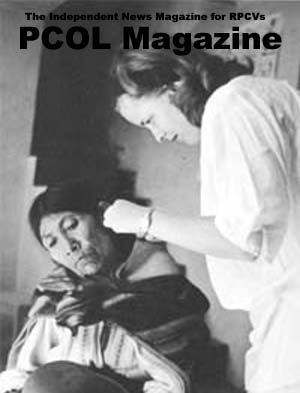
5. Actively engage Volunteers, returned Volunteers and the American public through strong partnerships with private sector companies, schools, civil society, returned Peace Corps Volunteer groups and government agencies to increase understanding of other cultures and generate commitment to volunteerism and community service as a way to "continue service."
6. Strengthen the Peace Corps' management and operations by using modern technology, innovative approaches and improved business processes that will enable the agency to effectively carry out this new strategic vision.
E. NEW STRATEGIES TO MAGNIFY PEACE CORPS' PRESENCE, IMPACT AND REACH
1. Target the Peace Corps resources and country presence across countries according to specific country selection criteria to maximize grassroots development impact and strengthen relationships with the developing world.
The Peace Corps' mission and goals remain relevant and the agency continues to be one of the most cost effective U.S. foreign assistance programs, however the agency must do a better job conveying this to the American people. In particular, the Peace Corps needs to demonstrate that it is active in those countries where the Peace Corps' added value achieves the greatest impact and where the United States will benefit from strengthened relations and increased cross-cultural understanding.
The United States has many strategic priorities, and the Peace Corps is committed to advancing these priorities in the countries where it serves, as long as they are consistent with host country priorities. Whether these strategic priorities are technical in nature (food security, HIV/AIDS, education) or relate to building friendships and increased understanding, they should be consistent with the Peace Corps' mission.
As described in greater detail in chapter IV, the Peace Corps needs to apply a more coherent strategy in determining the size and distribution of its country portfolio in order to make the most strategic use of its scarce resources. This analysis should use specific, objective country selection criteria to enable the agency to make resource allocation decisions that will maximize achievement of its three goals and advance the priorities of host country partners and the United States.
The Peace Corps must always ensure that two criteria remain paramount in its decision to place Volunteers: a country's commitment to the Peace Corps, and the assurance that the safety and security of Volunteers and staff can be maintained. Beyond that, some of the criteria that the assessment team recommends the Peace Corps use to conduct a portfolio review include:
Countries where the Peace Corps has demonstrated its effectiveness or where it can be determined that it can be effective;
Countries where the need for the Peace Corps' programs is greatest;
Countries where the Peace Corps' presence compliments other U.S. investments and priorities;
Countries demonstrating cost effective operations and strong management capacity.
In conducting this portfolio review, the Peace Corps must be ready to make the tough choice to reduce Volunteer input or even close operations in some countries. The agency must also proactively seek opportunities to enter new countries or expand programs in existing countries where it can be more effective. The process of conducting this review will be based on existing data sources and input from the agency's many stakeholders. In the end, the process will reflect the Peace Corps' best judgment of where it can strategically maximize its effectiveness and impact. The agency has already initiated the process of undertaking this portfolio review and will complete it during the fourth quarter of FY 2010. The agency has also committed to carrying out this portfolio review annually, in the fourth quarter of every fiscal year.
2. Focus on a more limited number of highly effective technical interventions that will enable the Peace Corps to demonstrate impact and achieve global excellence.
A key element of this six point strategy is embracing the fact that 85 percent of the agency's Volunteers are recent college graduates with little or no professional experience. These generalists are well-educated, highly motivated, and capable of becoming effective agents of change with the right training and support. Training programs must be tailored to the needs of these less experienced Volunteers. If the Peace Corps is to be a leader in the global effort to further human progress, it must be the partner of choice for foreign governments, international organizations, and local partners. The Peace Corps will only achieve this status if it can train Volunteers to deliver highly effective technical interventions that are most critical to addressing the needs in the communities they serve.
Although the Peace Corps states that Volunteers work in six primary sectors (education, health and HIV/AIDS, agriculture, environment, youth development and business), Volunteers actually work in 211 different projects that can be grouped into fifty different technical programs. The Peace Corps cannot effectively train and support Volunteers in so many different technical programs. Furthermore, projects are currently designed by posts with uneven agency guidance, limited technical oversight, and minimal opportunity for sharing good and promising practices among posts.
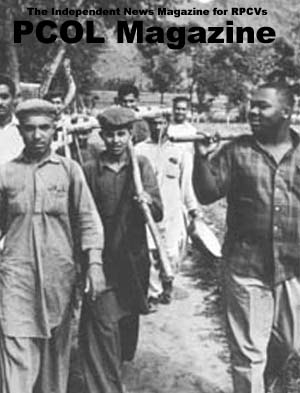
The Peace Corps needs to identify a smaller set of technical interventions that maximize impact and that can be easily mastered by the Peace Corps' generalist Volunteers. Once identified, the agency needs to establish technical training programs and support involving far greater vigor and depth to ensure generalist Volunteers are soundly prepared for service. Focus down-train up.
The agency should commit to excellence in this reduced set of interventions, and orient its training, programming, and management support to that end. These technical interventions will also benefit from improved technical oversight and more rigorous knowledge management to facilitate cross-border sharing.
A more focused strategic lens will allow the Peace Corps to create partnerships with recognized technical experts from academia, civil society, government and the donor community in each priority sector to better inform Volunteer training, technical support, monitoring and evaluation. Ideally, pre-service training will be complemented with scheduled in-service training, the development of targeted tools and job aids, and regular supervision by the Peace Corps' training and technical specialists. By working closely with global leaders in the development of rigorous technical training, it may be possible for Volunteers to earn a certificate of proficiency which would certify their attainment of a standard of competence in that subject. Such a certification would strengthen Volunteer motivation and offer a career boost at the end of their service.
While the assessment team did not feel comfortable defining the set of interventions the Peace Corps should select, the team is confident that the Peace Corps has the capacity to determine those technical areas where it can be most effective. By combining agency knowledge with input and strategic thinking from the field, host countries, U.S. government, academia and civil society partners, the Peace Corps can focus the work of its Volunteers, in a way that will most effectively contribute to the national development of the host countries. To assist in the prioritization process, the assessment team recommends that the Peace Corps consider the following selection criteria in making its choices:
Excellence: What do Peace Corps Volunteers do best?
Demand: What do the communities and partners served want?
Synergy: What are the strategic priorities of the host country and of the United States?
Training: What can the Peace Corps effectively train Volunteers in to achieve a high level of success in their work?
Impact: What are the technical areas where the agency will have the greatest impact?
As the agency targets its program focus and builds stronger technical training programs, the ability of each Volunteer to work with their community partners to address local needs beyond the Volunteer's primary assignment will continue to be a critical element of the Peace Corps' contribution. For example, a water systems Volunteer would still be assigned with a host agency partner and a host counterpart to work on water systems. However, the Volunteer will still be encouraged to also start a soccer team or develop an English club. Peace Corps staff overseas would be confident in providing partners with enthusiastic Volunteers capable of integrating and working alongside them, as well as Volunteers with applicable skills to achieve the goals of their assignments.
Instead of waiting months for meaningful work in their communities-a challenge expressed by many Peace Corps staff, Volunteers, and returned Volunteers providing input for the assessment-individuals serving within a more focused agency would contribute much earlier. The Peace Corps' effectiveness and impact would increase, with the spirit of community service and community integration intact.
The process of identifying the targeted interventions and developing stronger technical training programs should move ahead immediately, and must do so with an understanding that not all current projects will continue to operate as they have in the past. The agency should proceed by identifying and rolling out selected interventions sequentially, instead of attempting to implement the full scope of the proposed focusing at this time. In each target area, the agency will also need to determine the most appropriate training curriculum and best delivery method for that training, working with staff to scale-up that intervention prior to identifying the next.
3. Embrace generalist Volunteers, recruit them recognizing the competition for their services, and provide them with training and comprehensive support for success in their project areas and community outreach activities.
Despite significant agency efforts over the years to attract Volunteers with greater professional experience, generalists comprise 85 percent of the Peace Corps' Volunteer force today, and will continue to be the primary target audience for the Peace Corps' recruitment efforts. However, today's generalist applicants are very different from their predecessors. They are likely to be technologically savvy and highly focused on building a career. They have different expectations and are not as likely to wait out the agency's twelve month application process.
The Peace Corps began as a revolutionary idea. It captured the imagination of young people in the 1960s and Americans joined en masse. It was the post college experience for adventurous, committed, altruistic young people. Apart from missionary service, it was one of only a few options for people who longed to serve in international destinations.
Today's generalist applicant has many alternatives to the Peace Corps that did not exist in the past. Many options for international service in various programmatic sectors, geographic locations, and lengths of service are now available. The Peace Corps faces competition from domestic and international volunteer organizations that are successfully tapping into the market for highly motivated well-educated college graduates-traditionally the agency's focus.
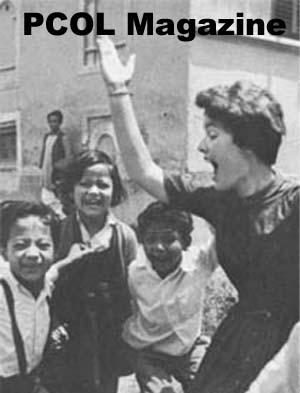
The Peace Corps must be willing to consider new recruitment models, using all of the digital tools and interpersonal approaches that appeal to today's target applicant. The agency still offers a unique international volunteer experience that American's continue to seek. The time is now to revitalize the Peace Corps' recruitment and marketing strategies to capture the imagination of today's applicants with messages that appeal to them where they are-in their homes, cars, jobs, cell phones, and computers.
Once on board, the Peace Corps must establish a new level of commitment to ensuring Volunteers will receive world-class language, cultural and technical training in preparation for meaningful work that awaits them. Applicants should look to the Peace Corps as the service option of choice, as they know that the Peace Corps' training provides real skills, valuable for their Volunteer service and throughout their professional careers. Applicants should feel confident that the Peace Corps' training is followed by an assignment to a community where their skills and expertise are needed, wanted and will allow them to make a difference. After beginning their work, they should know an ongoing training program is in place throughout their service to constantly maximize their effectiveness.
Given the importance of training to Volunteer success in the field, the assessment team recommends the Peace Corps allocate greater resources for hiring more full-time training staff at post, ensure greater counterpart participation in training events and provide ongoing investment in key training staff. The rigorous application of effective training programs simply cannot be accomplished at the appropriate level by part-time or consultant training staff.
Now is the time to offer levels of training surpassing what is currently provided, both in quality and depth, guaranteeing applicants that service in the Peace Corps will provide not only an opportunity to serve others, but skills and training necessary to make an impact and an unmatched opportunity for professional growth.
4. Make Peace Corps Response an engine of innovation by piloting new programs to expand the Peace Corps' presence and technical depth and increase overseas service opportunities for talented Americans
Peace Corps Response -formerly known as Crisis Corps-provides returned Peace Corps Volunteers the opportunity to serve in rewarding, short-term assignments in developing countries. To date, more than 1,100 Peace Corps Response Volunteers have served in over 40 countries in Latin America, Africa, the Pacific, Asia, and Eastern Europe and, following hurricane Katrina, 272 Peace Corps Response Volunteers were deployed in the United States. Assignments include enhancing existing agency programs, responding to natural disasters, initiating first-time programs in new Peace Corps countries, or returning to a country where there has not been a Peace Corps presence for some time. Peace Corps Response Volunteers bring the skills and experience gained during their previous Peace Corps service to new short-term projects in places where they are needed most. Unfortunately, Peace Corps Response is still very small, and currently lacks the technological capacity to process a larger number of applications. Nevertheless, Peace Corps Response is currently able to meet host countries requests for specific skill sets on a faster turn-around time than traditional Peace Corps programs.
The assessment team recommends developing an expanded Peace Corps Response program to attract and support more experienced individuals. Breaking from the current mission of Peace Corps Response, assignments would be open to those who could meet qualification criteria, whether or not they had been Peace Corps Volunteers in the past. This program would place experienced and qualified individuals into assignments that draw on their specific skills and experience, with flexible time commitments.
Overseas posts could request a Volunteer with a specific skill set from Peace Corps Response or Peace Corps Response could notify posts of the availability of individuals with specific skills and experience. The Peace Corps' new strategy to expand Peace Corps Response to any American who has the requisite technical skills and professional experience to address some of the world's most critical needs is a bold leap forward. By doing so, the agency will allow more Americans the opportunity to serve overseas with the Peace Corps and bring greater diversity and experience to the Peace Corps portfolio. Opening Peace Corps Response to all qualified Americans will enable those who are not able to commit to two years with the opportunity to serve on shorter-term assignments in a country that desperately needs their skills. It improves the chances that the Peace Corps can successfully and adequately fill requests from host countries for Volunteers with a broader and deeper set of technical skills. This will be particularly important if the Peace Corps begins to focus its traditional program on a more targeted set of technical interventions.
Response Volunteers can become mentors to the Peace Corps' Volunteers and their host country counterparts, with assignments that complement the efforts of the traditional two-year Peace Corps Volunteer. An expanded Response program will also rapidly increase the number of Americans who feel kinship with the Peace Corps, enabling the agency to more fully achieve its three goals through broader participation. Peace Corps Response will provide targeted training for Response Volunteers, depending on Peace Corps Response has its roots in an ad hoc and intermittent practice that developed in the 1970s of sending Returned Peace Corps Volunteers on short term assistance assignments, including to countries where there was no Peace Corps presence. In 1996, the process was formalized and Crisis Corps, an office at the Peace Corps dedicated to disaster relief, was established. In 2007, following a gradual change in requests for Volunteers with more technical skills in countries that were not experiencing a disaster or crisis the program was renamed "Peace Corps Response." Peace Corps Response Volunteers are placed in short-term, high impact assignments ranging from three months to one year. 2 Returned Peace Corps Volunteer's would be able to continue serving in Peace Corps Response for shorter periods of time.
The Peace Corps has already begun using Response Volunteers to enter new countries or return to former host countries, particularly those that are recently post-conflict, such as Liberia and Sierra Leone. This model has enabled the Peace Corps to test the waters and take the time to build up an infrastructure before committing to a full-fledged two year Volunteer program.
5. Actively engage Volunteers, returned Volunteers and the American public through strong partnerships with private sector companies, schools, civil society, returned Peace Corps Volunteer groups, and government agencies to increase understanding of other cultures and generate commitment to volunteerism and community service as a way to "continue service."
The world today is dramatically different from the one in which the Peace Corps was founded. Advancements in information technology, transportation, agriculture, industry, and communication have transformed the world into a fluid global economy. The face of the country is changing. The United States has always been the land of immigrants, and that has never been more true than today. Today's citizens need to embrace the diversity that is America, and prepare to live in an increasingly interdependent world. Based on their experiences, current Volunteers and returned Peace Corps Volunteers have unique potential to actively promote global citizenship through Internet and school-based programs targeting young people to educate about countries and cultures around the world.
At the same time, although the United States remains a dominant power, the country faces numerous social challenges that drain its resources and compromise the country's national development. Current Volunteers and returned Peace Corps Volunteers know what it is like to "live" community service, and have the tools, knowledge and experience that come from this immersion. They understand that citizen action is key to addressing national priorities from the ground up. They have witnessed the power of individual and collective innovation to transform neighborhoods. There is great potential in the returned Peace Corps Volunteer community to help foster innovation and change in communities in the United States, just as they did in their host countries.
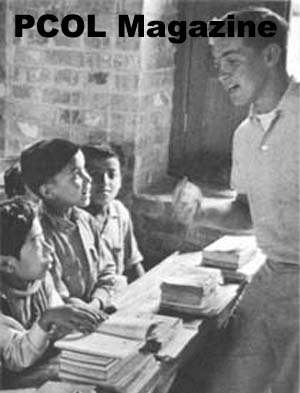
To date, however, this potential has been largely untapped by the Peace Corps, as the agency's efforts have focused more squarely its first and second goals. However, the Peace Corps' senior leadership is dedicated to bringing the world back home by more extensive partnering with private sector companies, schools, civil society, returned Peace Corps Volunteer groups and government agencies to promote global citizenship and volunteerism as a way to "continue the service" and help address pressing national challenges.
The Peace Corps can more effectively mobilize Volunteer passion and commitment with a few small steps, including reinforcing the expectation that "bringing the world back home" is a long-term commitment at every stage of the Volunteer lifecycle-recruitment, training, volunteer service, and return home. The Peace Corps should be proactive in developing a set of tools to assist Volunteers in this effort-both in pre- service training and post-service training. Now known as Completion of Service (COS) training, the assessment team believes that it should be re-positioned as "Continuation of Service" training, with concrete tools and resources to guide and support Volunteer efforts. With that in mind, the assessment team recommends that the Peace Corps pursue a third goal strategy focusing on two main initiatives.
1. Increase participation and expand the Coverdell World Wise Schools (CWWS) program and other school-based initiatives to promote global citizenship, while also engaging other non-school audiences;
The Coverdell World Wise Schools program is a strong partner in U.S. efforts to teach American school children how to be global citizens. CWWS has three primary activities: first, its classroom resources program, where CWWS develops and distributes lesson plans, educational videos, podcasts and interactive simulations of Peace Corps Volunteer activities to primary and secondary schools around the country; second, its CWWS Correspondence Match program that connects U.S. elementary and secondary school teachers with current Volunteers who share their Peace Corps experiences at least once a month through letters, emails, photos, artifacts, and/or phone calls. Lastly, the CWWS Speakers Match program connects U.S. educators with returned Peace Corps Volunteers who agree to share their Peace Corps experiences in elementary schools, high schools, and colleges in their communities. These efforts should be continued and expanded to include greater participation from serving Volunteers, wider involvement from American schools and increased utilization of social media and technology.
Beyond the CWWS program, the Peace Corps should actively seek partnership with like-minded organizations, universities, foundations, policy groups and returned Volunteer groups to expand support and commitment to global citizenship. There are many opportunities to participate more widely in the global debate about the benefits of volunteer service and the importance of global citizenship through leadership roles in conferences, workshops, professional journals, and popular media. Initiatives such as the Global Service Fellows provide opportunities for greater public discourse on this important topic. More active engagement in the public debate on the role of global citizenship will require a higher level of senior management staff commitment in the future.
2. Create partnerships to scale up returned Peace Corps Volunteer participation in activities to share their experience and support innovative community service.
Agency leadership is firmly committed to the assessment team's recommendations for the Peace Corps to begin addressing the invaluable domestic dividend of Peace Corps service through a dramatically more structured and engaging approach to third goal efforts. In addition to current agency programs, the Peace Corps is building a network of strategic partnerships with targeted domestic non-profit organizations to connect returned Peace Corps Volunteers with broader opportunities to "continue service" in ways that help address pressing national problems. Over the past nine months, the Peace Corps has entered into formal partnerships with the National Peace Corps Association, the National Association of Community Health Centers, City Year, and The Corps Network, and will continue to build relationships with many other non- profits, businesses, universities and returned Peace Corps Volunteer groups in the future. An important partner in this effort is the White House Office of Social Innovation and Civic Participation, which works with federal agencies to create tools, such as innovation funds, prizes, and other social capital market structures to drive resources towards community solutions that demonstrate success. All of these partners have strong programs where returned Peace Corps Volunteers can build upon their Volunteer experience to support community solutions to America's toughest challenges.
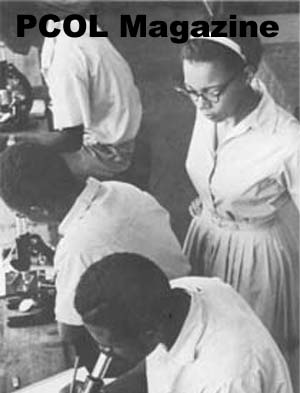
These efforts must be expanded and more widely promoted. If the Peace Corps is to prioritize third goal activities, it must raise their profile within the agency and increase the proportion of funding directed to their implementation. It must also pursue innovative new approaches, such as establishing a Peace Corps Intern program allowing some of the agency's top Volunteer talent from overseas to complete a year-long paid internship in the United States with key development partners as well as private and public sector organizations who would benefit from the unique perspective brought to their organization by a recently returned Peace Corps Volunteer.
The National Peace Corps Association has suggested additional innovative ideas to encourage returned Peace Corps Volunteers to participate more actively when they return home, and these should be given strong consideration. They include a proposal to encourage newly returned Volunteers to plan, conduct and report on third goal activities over an additional period of time following their return home, with a modest financial incentive for doing so. Another idea is to create a small grants program to expand innovative third goal activities using new technologies to reach new audiences. The Peace Corps' funds for this purpose would be leveraged by a match from the National Peace Corps Association.
6. Strengthen the Peace Corps' management and operations by using modern technology, innovative approaches and improved business processes that will enable the agency to effectively carry out this new strategic vision.
The strategy described above is exciting and proactive, but its implementation will require continued advancements in innovation and improved management practices. As a government agency, the Peace Corps has significantly less bureaucracy than most. But it has suffered from years of budget cuts, as have many agencies, that have whittled away funding for key functions such as Volunteer training and staff development, and limited its ability to modernize its systems and processes, particularly in the area of information technology.
Several areas for substantive work were noted by the assessment team, including the need for a serious look at the human resources necessary at headquarters and (especially) the field to follow through with the rigorous training program and Volunteers support measures described in this strategy. This is an excellent time to focus on strengthening full-time training capacity at the field level, supplementing that with a new cadre of highly skilled technical advisors at the headquarters and/or regional levels to support the Peace Corps' move to support a more rigorous technical agenda.
The Obama Administration has prioritized innovation and Open Government, and the Peace Corps is eager to adapt and modernize its systems so that it can provide a much higher level of efficiency, transparency and quality in its operations. The Volunteer Delivery System, currently in development, will streamline the application process for new recruits, improving the timeliness and quality of the recruitment process, and hopefully reducing dramatically the number of applicants lost to drop-out. The Peace Corps is embarking on a new electronic medical records initiative in order to improve the quality of Volunteer health care and streamline the management of Volunteer health services.

In recent years, the Peace Corps has much more proactively sought to improve monitoring and evaluation practices, and has conducted a series of country impact studies that provide some valuable results to strengthen country programs and disseminate best practices more widely. The Peace Corps is committed to improving its capacity in this area, and has provided strong leadership in the Office of Strategic Information and Planning who work closely with monitoring and evaluation staff at the Office of Overseas Programming and Training Support to improve monitoring and evaluation practices. An improved monitoring and evaluation system would not only strengthen the quality of training and technical support to Volunteers, but it will also lead to better communication of results to all stakeholders. The Peace Corps will need to assess both the human resource and technology requirements of strengthening its monitoring and evaluation capacity to collect, analyze, use and disseminate data for more effective decision-making. The Peace Corps also needs to drastically strengthen its knowledge management capacity using an integrated, systematic approach to identifying, acquiring, storing, disseminating, using, and sharing the Peace Corps' knowledge.
F. IMPLEMENTATION
The implementation of the new vision and the supporting strategy will not come without challenges to the agency and its current program model. Commitment from the agency's leadership as well as regular and consistent communication through all levels of the Peace Corps' operations will be essential. In addition to the inherent challenges associated with making substantive change to any organization, there will be tangible implications in regards to resources, staff, systems and operations. Many of these challenges will require fresh approaches and a spirit of innovation. The assessment team believes the challenges can be overcome, and many provide opportunities for further revitalizing and strengthening the Peace Corps.
The agency must also be prepared to address changes in staffing necessary to support this new strategic vision. New positions will be created; some positions will evolve, and staff training needs will be increased. These new challenges that also present opportunities, including the opportunity for retraining and reinvigorating overseas and domestic staff.
In an agency that sees frequent turnover at all levels because of the Five Year Rule and political appointments, the Peace Corps faces a particular challenge to the successful implementation of this strategy. However, the assessment team believes that the Peace Corps is capable of making such a change so that strategic, evidence-based decisions become standard operating procedure regardless of future leadership transitions.
The implementation of this strategy will require strong leadership. The Peace Corps is at a turning point, and action taken now will have a tremendous impact well into the future. With the 50th anniversary fast approaching, the Peace Corps must take a quantum leap in strategy and resolve to be ready for the next fifty years, which, if the agency stays the course, holds the promise to be even better than the first half century.
G. PLAN OF ACTION
The Peace Corps' leadership plans to establish a team to oversee the implementation of the vision and six key strategies presented in this assessment. Led by a project manager, the implementation team will work under the supervision of the Office of the Director, and in close collaboration with the rest of the agency's management. While this team will develop the implementation plan, the assessment team believes the cornerstones of the plan must include the following thirteen points:
1. Establish a plan to address the impacts on overseas operations in a collaborative manner with the Peace Corps' staff in the field:
Communicate changes to current operations and impacts on staff; Determine changes to current projects and country programs; Determine new country programs and interventions to be pursued; Establish a training program for host country staff whose role with the Peace Corps will change; and, Deliver regular communication and establish open and ongoing dialogue with the field.
2. Examine why the agency operates where it operates with the Volunteer levels assigned to each country and geographic placements of Volunteers within each country. Develop a strategic approach to country assignments, Volunteer allocations, and Volunteer placements within individual countries. 17
This approach should be based on criteria that consider grassroots development needs, interventions in which the Peace Corps would have the greatest development impact, opportunities for strengthened relations between the United States and the host country, Volunteer health and safety, and the likelihood of Volunteers achieving the agency's three goals.
3. Determine specific technical interventions through a collaborative process that uses field knowledge, headquarters perspective, and input from leading development organizations and partners. Identify and roll out each intervention sequentially.
4. Assess the adequacy of the Peace Corps' current management structure and business model and make appropriate adjustments to ensure resources are dedicated for the successful implementation of the vision and its supporting strategies.
5. Develop a dynamic and broad communications strategy that uses technology and social media to support the agency's new strategic vision. The communications strategy should utilize the 50th
Anniversary of the Peace Corps as an opportunity to deliver the agency's new strategic vision to the public, agency staff, partners, host governments, Volunteers, potential Volunteers, Congress, and the greater Peace Corps community.
6. Redesign and enhance Peace Corps Response to implement its new role as defined in this assessment.
7. Develop a strong communications strategy for Peace Corps Response, highlighting its new innovative approaches and significant changes.
8. Develop a recruiting strategy and a new recruiting model for the Peace Corps and Peace Corps Response to implement the plan.
9. Establish a standardized core technical training program in the specific technical interventions identified, and determine the most effective method for such training.
10. Establish and strengthen partnerships overseas and in the United States to support the implementation of the plan.
11. Develop a more streamlined and effective monitoring and evaluation system to evaluate the success of the implementation plan.
12. Aggressively ramp up school, private sector, civil society, and government agency engagement to achieve third goal of the Peace Corps, while committing agency resources and energy to third goal programs with measurable impact.
13. Celebrate the 50th Anniversary of the agency by acknowledging the Peace Corps' history, but focusing most of its efforts on enthusiastically confirming why the best years of the Peace Corps are yet to come.
H. SUMMARY OF FINDINGS, RECOMMENDATIONS, AND STRATEGY FOR IMPLEMENTATION
Over the course of the assessment team's extensive outreach efforts to solicit input for this comprehensive assessment, no single topic was mentioned with greater frequency than the need for the Peace Corps to identify and articulate a powerful strategic vision to guide the agency in the coming years. As the Peace Corps prepares to turn 50, current and former Volunteers and staff members, advocates, critics, and members of Congress believe the agency needs to reflect on the lessons it has learned in the past 49 years and needs to restructure for a world dramatically different than the one in which it was formed in 1961 to ensure the 50th anniversary of the Peace Corps is substantially more forward-looking than reflective.
The assessment team makes two overarching recommendations:
Recommendation II-1:
The assessment team recommends the Peace Corps adopt the proposed vision and the six supporting strategies necessary to implement this vision. Recommendation II-2:
The assessment team recommends the Peace Corps immediately establish a team to oversee the implementation of the proposed vision and its six pronged strategy and develop an implementation plan with timeline and deliverables to ensure successful adoption of the plan. Specifically, the assessment team recommends:
1) Targeting the Peace Corps' resources and country presence across countries according to specific country selection criteria to maximize grassroots development impact and strengthen relationships with the developing world (See chapter IV);
2) Focusing on a more limited number of highly effective technical interventions that will enable the Peace Corps to demonstrate impact and achieve global excellence;
3) Embracing generalist Volunteers, recruiting them recognizing the competition for their services, and providing them with training and comprehensive support for success in their project areas and community outreach activities (See chapters VI and VIII);
4) Making Peace Corps Response an engine of innovation by piloting new programs to expand the Peace Corps' presence and technical depth and increase overseas service opportunities for talented Americans (See chapter VI);
5) Actively engaging Volunteers, returned Volunteers and the American public through strong partnerships with private sector companies, schools, civil society, returned Peace Corps Volunteer groups and government agencies to increase understanding of other cultures and generate commitment to volunteerism and community service as a way to "continue service" (See chapter XI); and,
6) Strengthening the Peace Corps' management and operations by using modern technology, innovative approaches and improved business processes that will enable the agency to effectively carry out this new strategic vision (See chapter V).

The time has come for the Peace Corps to not only embrace its rich history, but also clearly define and powerfully articulate why its best years are yet to come: why Americans should be excited to serve; why the Peace Corps is one of the U.S. government's most strategic investments; and why countries, non- governmental organizations and communities around the world should pursue partnership with the Peace Corps. With President Obama's call to service, the 50th anniversary, and the strong development background of the current Director and his staff, the Peace Corps' is ready to implement a powerful set of new strategies to magnify the Peace Corps' presence, impact and reach.
RECOMMENDATION LEAD OFFICE SUPPORT OFFICE(s) TIMING
II-1 The assessment team recommends the Peace Corps adopt the proposed vision and the six supporting strategies necessary to implement this vision. Office of the Director Begin Immediately
II-2 The assessment team recommends the Peace Corps immediately establish a team to oversee the implementation of the proposed vision and its six pronged strategy and develop an implementation plan with timeline and deliverables to ensure successful adoption of the plan. Specifically, the assessment team recommends:
1) Targeting the Peace Corps' resources and country presence across countries according to specific country selection criteria;
2) Focusing on a more limited number of highly effective technical interventions;
3) Embracing generalist Volunteers, recruiting them recognizing the competition for their services, and providing them with training and comprehensive support for success;
4) Making Peace Corps Response an engine of innovation by piloting new programs to expand the Peace Corps' presence and technical depth;
5) Actively engaging Volunteers, returned Volunteers and the American public through strong partnerships to increase understanding of other cultures and generate commitment to volunteerism and community service as a way to "continue service"; and,
6) Strengthening the Peace Corps' management and operations by using technology, innovative approaches, and improved business processes. Office of the Director Office of Global Operations; Office of the Chief Financial Officer; Africa Region; Europe, Mediterranean, and Asia Region; Inter-America and the Pacific Region; Posts; Office of the Director; Office of Communications; Office of Strategic Information, Research and Planning; Office of Overseas Programming and Training Support Begin Immediately
Read the full reports at the following links:
http://peacecorpsonline.org/messages/documents/PC_Comprehensive_Agency_Assessment.pdf
http://peacecorpsonline.org/messages/documents/PC_Comprehensive_Agency_Assessment_Appendices.pdf
Story Revised on July 27, 2010.
Links to Related Topics (Tags):
Headlines: June, 2010; Peace Corps Headquarters; Safety and Security of Volunteers; Congress; Peace Corps Foundation
When this story was posted in July 2010, this was on the front page of PCOL:
Peace Corps Online The Independent News Forum serving Returned Peace Corps Volunteers 








 | Memo to Incoming Director Williams
PCOL has asked five prominent RPCVs and Staff to write a memo on the most important issues facing the Peace Corps today. Issues raised include the independence of the Peace Corps, political appointments at the agency, revitalizing the five-year rule, lowering the ET rate, empowering volunteers, removing financial barriers to service, increasing the agency's budget, reducing costs, and making the Peace Corps bureaucracy more efficient and responsive. Latest: Greetings from Director Williams |
Read the stories and leave your comments.

Some postings on Peace Corps Online are provided to the individual members of this group without permission of the copyright owner for the non-profit purposes of criticism, comment, education, scholarship, and research under the "Fair Use" provisions of U.S. Government copyright laws and they may not be distributed further without permission of the copyright owner. Peace Corps Online does not vouch for the accuracy of the content of the postings, which is the sole responsibility of the copyright holder.
Story Source: Peace Corps Press Release
This story has been posted in the following forums: : Headlines; HQ; Safety; Congress; Planning; Foundation
PCOL45844
12


















